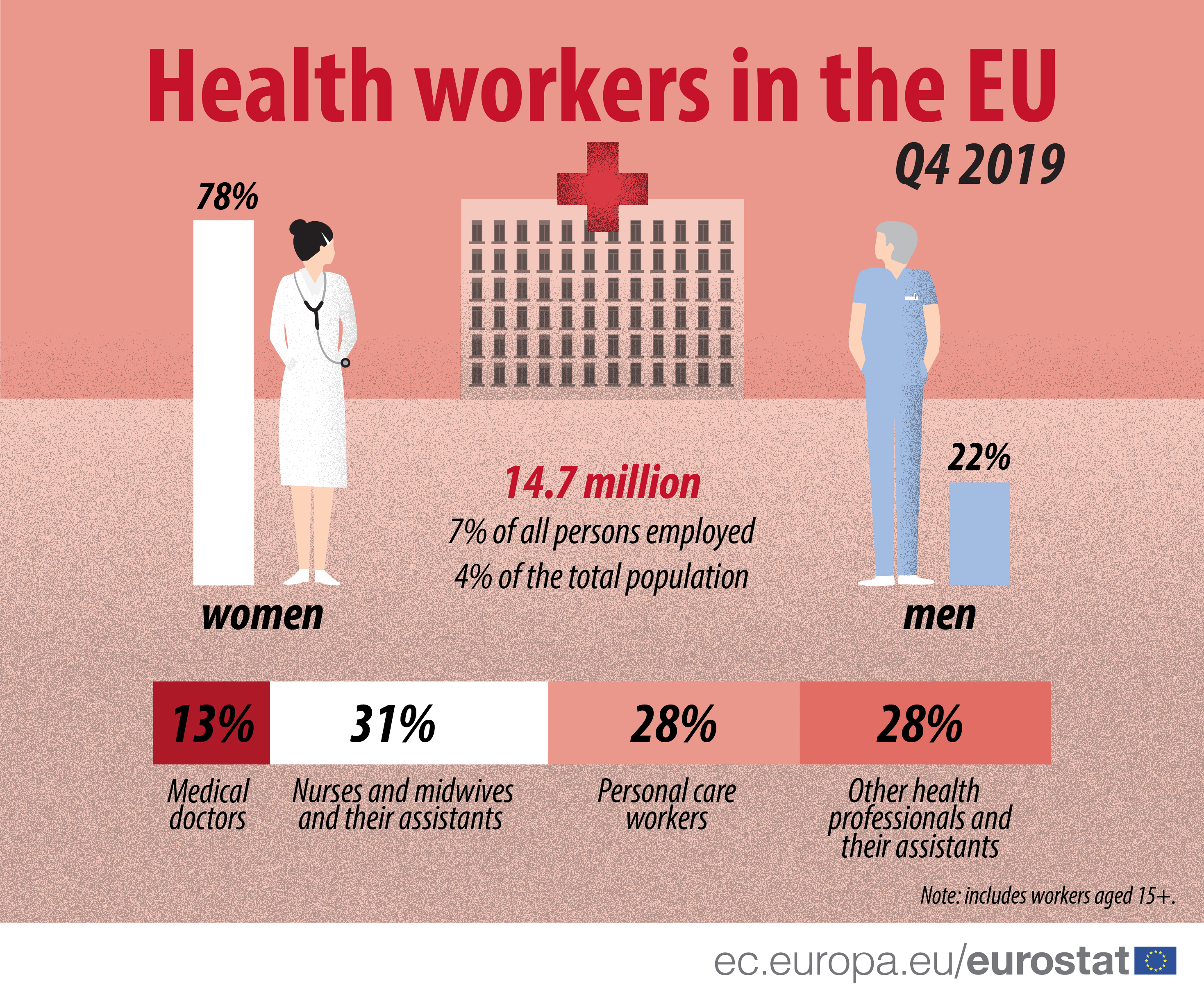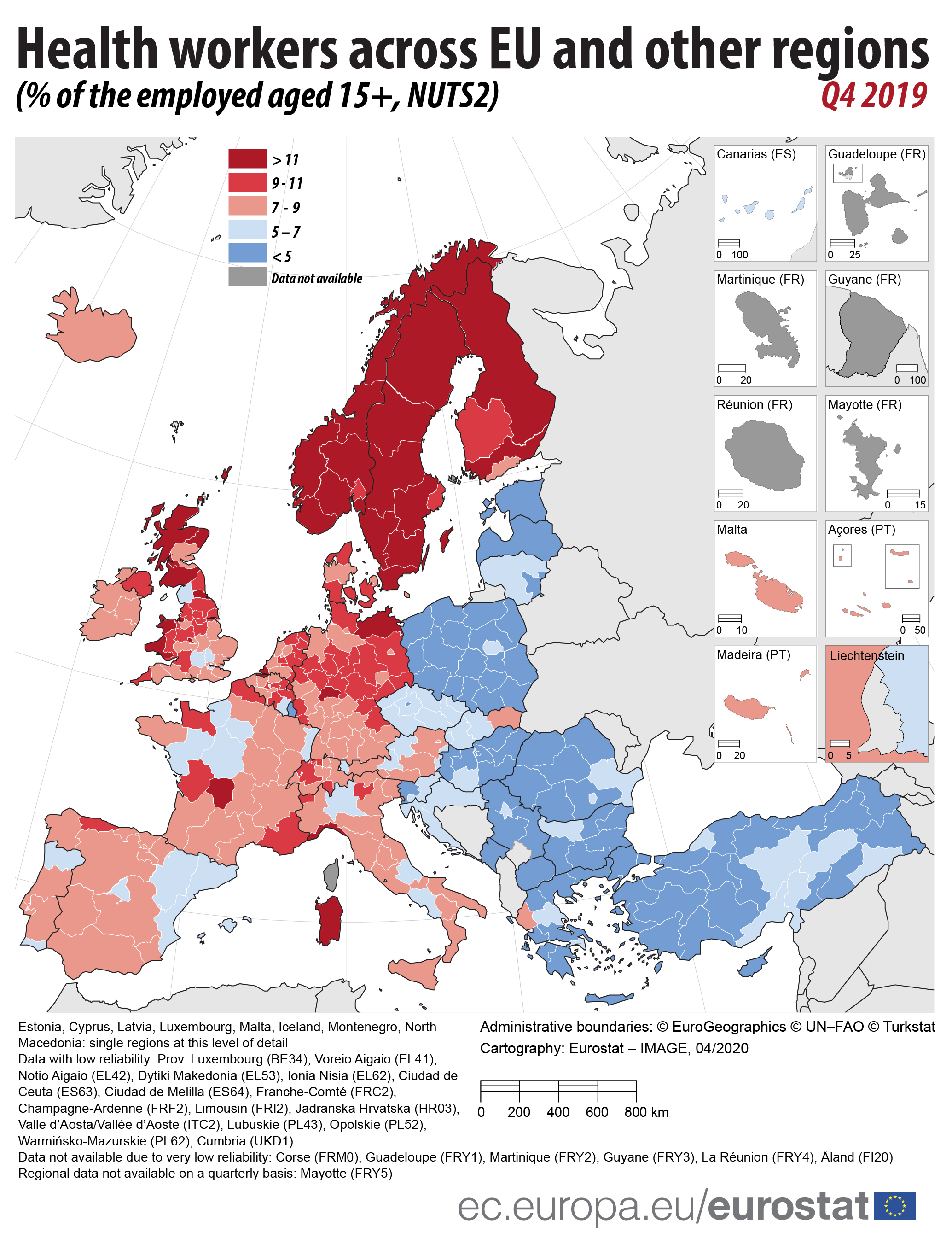In the last quarter of 2019, 14.7 million people aged over 15 were employed in health occupations in the European Union (EU), representing over 7% of all persons employed and almost 4% of the total population.
These health jobs include medical doctors (1.9 million), nurses and midwives as well as their assistants (4.5 million), personal care workers (4.1 million), other health professionals and their associates (4.1 million). Every evening at 8pm, we clap at our doorsteps, windows and balconies to show them our appreciation during the coronavirus crisis.
The vast majority of the health workers were women (78%). Over one third (36%) of people in health occupations in the EU were 50 years old or over, followed by those aged 35 – 49 (35%) and those less than 34 (29%).
In half (13 of 27) of the EU Member States, the largest share of health workers were aged over 50, with the highest share reported in Bulgaria (56%), followed by Estonia and Latvia (both 50%), Italy (45%) and Lithuania (42%).
In 11 EU Member States, people aged 35 - 49 accounted for the largest share of health workers, whilst in only three EU Member States health workers aged 15-34 represented the largest share: Malta (50%), Luxembourg (47%) and Cyprus (38%).
Among the EU Member States, Sweden recorded the highest share of health workers (12% of the employed), followed by Finland and Denmark (both 10%). In contrast, the lowest shares were recorded in eight EU Member States: Cyprus, Poland, Latvia, Romania, Luxembourg, Bulgaria, Hungary and Slovenia, where health workers represented around 4% of the employed.
Relative to population size, Sweden also recorded the highest share (7% of the total population), similarly followed by Finland, Denmark as well as the Netherlands (all 6%). At the other end of the scale, the lowest shares were recorded similarly in Poland, Romania, Cyprus, Bulgaria, Latvia, Luxembourg, Hungary and Slovenia but also in Greece. In these nine EU Member States health workers represented only around 2% of the total population.
Spotlight on health workers in EU regions
With the exception of Sardegna (14% of the employed) and Liguria (13%) in Italy, the highest shares of health workers were generally recorded in northern regions of the EU, namely in:
- seven Swedish regions: Övre Norrland and Mellersta Norrland (both 16%), Norra Mellansverige and Östra Mellansverige (both 14%), Småland med öarna (13%), Sydsverige and Västsverige (both 12%),
- Pohjois- ja Itä-Suomi (13%) in Finland as well as
- Zeeland (12%) in the Netherlands.
Note:
- Health occupations in this article, as defined under ISCO-08 classification, include: 221 - Medical doctors, 222 - Nursing and midwifery professionals, 226 - Other health professionals, 322 - Nursing and midwifery associate professionals, 325 - Other health associate professionals and 532 - Personal care workers in health services.
- Estonia, Cyprus, Latvia, Luxembourg, Malta, Iceland, Liechtenstein, North Macedonia: single regions at this level of detail
- Regional data with low reliability: Prov. Luxembourg (BE34), Voreio Aigaio (EL41), Notio Aigaio (EL42), Dytiki Makedonia (EL53), Ionia Nisia (EL62), Ciudad de Ceuta (ES63), Ciudad de Melilla (ES64), Franche-Comté (FRC2), Champagne-Ardenne (FRF2), Limousin (FRI2), Jadranska Hrvatska (HR03), Valle d’Aosta/Vallée d’Aoste (ITC2), Lubuskie (PL43), Opolskie (PL52), Warmińsko-Mazurskie (PL62), Cumbria (UKD1)
- Regional data not available due to very low reliability: Corse (FRM0), Guadeloupe (FRY1), Martinique (FRY2), Guyane (FRY3), La Réunion (FRY4), Åland (FI20)
- Regional data not available on a quarterly basis: Mayotte (FRY5)
- The European Union (EU) includes 27 EU Member States. The United Kingdom left the European Union on 31 January 2020. Further information is published here.
To contact us, please visit our User Support page.
For press queries, please contact our Media Support.




